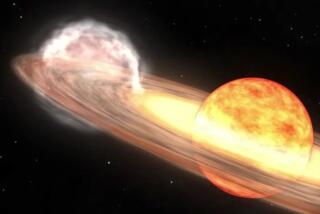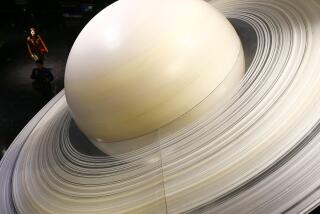Encounter With Uranus to Be Public Experience
When a rugged little spacecraft rips by Uranus about 2 billion miles away from Earth on Friday morning, a front-row seat will be reserved for John Q. Public.
In a continuing marvel of the Space Age, private citizens will be able to share in the thrill of discovery almost as soon as scientists directly involved in the project. Two communications satellites will beam the results to research facilities, universities, television networks, cable systems, and anybody who has a backyard satellite dish.
“We have notified 9,000 cable television systems that the service is available, but we never know who is going to use it,” said a spokesman for the Jet Propulsion Laboratory in Pasadena, which is running the Voyager 2 expedition.
One user will be the California Museum of Science and Industry in Exposition Park, which will carry live reports from JPL about the mission, and photographs from Voyager will be shown on the museum’s screens beginning Thursday morning. The live reports will include 10-minute, hourly updates at the top of the hour, a 10 a.m. press conference and various other briefings by scientists who have experiments aboard the spacecraft.
“We think it’s important for the public to have an opportunity to see such an historic occasion for themselves,” said Eugene Harrison, science curator for the museum.
Harrison said three 45-inch screens will be used for the project in the museum’s aerospace building.
The museum is open every day from 10 a.m. to 5 p.m., but the aerospace building will stay open an extra hour to carry an hourlong show from JPL summing up each day’s results, Harrison said. That program is to begin at 5 p.m. every day through Tuesday, except Saturday. The satellite communications system that the National Aeronautics and Space Administration uses, called “NASA select,” will be tied up Saturday covering the launch of the space shuttle Challenger, which will carry New Hampshire high school teacher Christa McAuliffe into space.
However, Saturday will probably be the most interesting day of all because it is then that the first photos from the close encounter are expected to be released.
Voyager 2, which has traveled about 3 billion miles in its tour of the outer planets, will make its closest approach to Uranus at 10 a.m. Friday. But it is so far away that it will take 2 hours and 42 minutes for data to travel from the spacecraft back to the Earth, and it will take a little more time for scientists to analyze the data and try to decide what it all means.
A JPL spokesman suggested that those interested in viewing the results from their homes call the cable system that serves their area to see if the programs will be carried. Anyone with a satellite dish can tune in to Satcom F2R, transponder 13, at 3954.5 megahertz, 72 degrees west longitude, or Westar 4, transponder 12, 4160 megahertz, horizontal polarization, 99 degrees west longitude. Satcom operates on a 24-hour basis, but Westar will carry the broadcasts only between 9:30 a.m. and 2 p.m., a NASA official said.
More to Read
Sign up for Essential California
The most important California stories and recommendations in your inbox every morning.
You may occasionally receive promotional content from the Los Angeles Times.










